
Aerial view of Tod Inlet in 1982. BC Archives I-03141.

Aerial view of Tod Inlet in 1982. BC Archives I-03141.
For many years, the future of Tod Inlet was in doubt, both from the perspective of pollution of the inlet and from the perspective of the use of the land, which was dependent on development decisions made by local governments.
On the environmental side Beatrice Elliott recalled that in the mid-1960s, her husband, Tsartlip Elder Dave Elliott Sr., had given a big speech at the BC parliament buildings about the terrible state of Tod Inlet: the sewage on the beaches, how disgusted he was at what was happening, and how he wanted to claim back some of the old ways. Not much had changed in the next decade.
Finally, following a meeting called in June 1970 between Hugh Curtis, Capital Regional District (CRD) chairman; officials from the Butchart Gardens; and representatives of the health, fish and game, and pollution-control agencies, action was taken to stop the pollution of Tod Creek and Tod Inlet. The owner of the Hartland Road dump was required to divert three small streams from entering the dump and to build a permanent dam to prevent dump seepage from reaching Tod Creek. In addition, the dump stopped accepting oil and paint, and posted signs directing garbage trucks to specific dumping sites. Eventually the CRD moved ahead and constructed facilities at the site to collect waste, which was then taken back to Victoria and sent out into the Strait of Juan de Fuca to be dumped.
There were also changes on the development front. Beginning in about 1975, Genstar, the newest owners of the old BC Cement properties, submitted several plans to the local municipal council to turn the lands surrounding Tod Inlet into a huge hotel-resort complex or an extensive housing development. There were various plans, but all of them included levelling the remnants of the old cement plant and building a marina, hotel, golf course and restaurant. Housing developments were proposed for the site of the workers’ homes, the old farm, the Chinese village and even the majestic forested hills that form the south shores of Tod Inlet.
On behalf of Genstar, BACM Development Corporation, a Winnipeg development company, proposed a 3,000-person community. This was just the beginning of the plan to develop the entire 1,200-acre site around Tod Inlet. They had further plans that would provide for recreation, commercial and other needs of the development. It included five to ten acres for a 150-berth marina with shore buildings and a parking lot, and a commercial zone of shops to serve the future neighbourhoods, which would eventually cover the entire acreage.
The first phase plan was to build the 900 units that would house up to 3,000 people. Seven acres of land were deemed suitable for apartment complexes, and two such complexes were proposed, with as many as 250 rental units. In total the development would include about 70 detached homes, 170 “terrace and cluster buildings” and up to 500 multiple-dwelling units. The 1,000-acre Partridge Hill area to the west of Tod Inlet and extending across to Saanich Inlet would wait for future development.
Part of the plan was to build a dike across the inlet, with a road on the dike to provide access to the marina and commercial area. The proposed dike location was at the Tod Creek estuary, perhaps one of the most fragile ecosystems of the whole inlet. The dike also would have destroyed two of the archaeological sites.
Citizens began urging local governments to pursue the idea of a park at Tod Inlet as a more suitable land use than the aggressive development proposed by the owners. My own letters to various politicians and government departments and the newspaper in 1978 were typical of what so many of us wanted to see: “I would like to suggest that the whole area at the head of Tod Inlet be purchased by the provincial government and developed, in moderation, as a historical-natural marine park. Tod Inlet is worth saving, not only as one of the most delightfully scenic areas on the Saanich Peninsula, but also as an interesting example of the growth and disappearance of a community and an interesting natural area in the process of growing back from a period of intense industrial development. The development of a marine park would beautifully complement Butchart Gardens, would ensure a certain increase in tourism, and would preserve the area for the education and enjoyment of future generations.”

Letter about Tod Inlet marine park in the newspaper, June 3, 1978. Author’s collection.
Ian Ross, owner of the Butchart Gardens, was one of many people who spoke out at public meetings urging the local council to pursue the idea of a park. The developers recognized the cultural value of the property and, hoping for approval, offered to donate the area of the cement plant and up to 20 acres on Tod Creek, including the site of the Chinese village, to the local government for park use if their proposals were accepted. In the meantime, Genstar had three of the towering chimneys toppled as a safety precaution in 1978.
Three of the old chimneys in the cement plant, in 1967. One is an original brick chimney from about 1904, and the other two were built in 1911–1913. David R. Gray photograph.
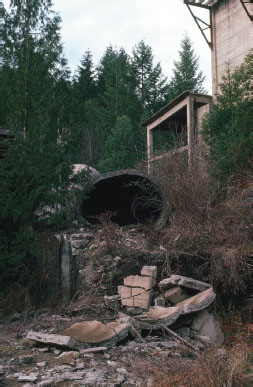
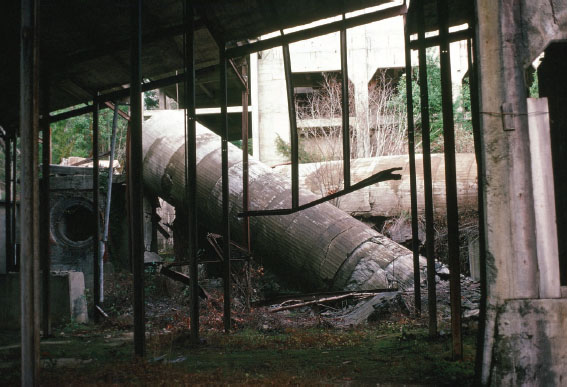
The toppled chimneys in the cement plant, 1978. David R. Gray photographs.
In the early 1980s, Genstar had most of the outbuildings demolished—the powerhouse, office building, machine shop and blacksmith shop—seeing them only as a “mess of derelict buildings” without historical significance.
When BC Cement and Ocean Cement, under their parent company Genstar, sold their Tod Inlet holdings to a local developer, Sam Bawlf, in March 1981, a new battle was engaged. One ramification of the change was that the members of the Tod Inlet Power Boat Owners’ Association were informed that all of their boats would have to be relocated.
While the new development proposals were being considered, environmentalists continued to do what they could to enhance the ravaged environment of Tod Inlet and Tod Creek.
In 1983 the Tod Creek Water Enhancement Society released 4,700 coho salmon fry into Tod Creek. A year and a half later there was a small but healthy run of returning salmon. Unfortunately, they were all eaten by the resident seals of Tod Inlet before they could enter the safety of Tod Creek.
During the stream enhancement the volunteers removed part of a rocky ledge across the creek by blasting and improved several pools by minor damming with small rocks. They also removed large fallen logs that were partially damming the creek. An area just above the creek mouth had been used as a local dumping ground as late as the 1960s, and large amounts of garbage and debris had been dumped down the banks into the creek. The society volunteers cleared out most of the larger debris, including old car bodies, as part of the stream enhancement program. As the restoration of the Tod Creek aquatic environment was under way, another project, under the federal government’s Katimavik program, had a team of students building streamside trails. These new trails gave better access to the creek and a more natural feeling for visitors than the wider, well-used former road above the creek.113
The CASE march and rally at Tod Inlet in 1990 in support of a proposed park. CASE photograph. Author’s collection.
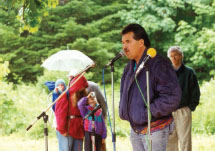
Tsartlip councillor John Elliott addressing the rally at Tod Inlet, 1990. CASE photograph. Author’s collection.
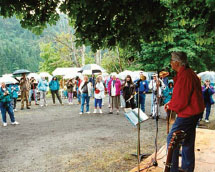
Derrick Mallard, of CASE, addressing the crowd at the rally at Tod Inlet, 1990. CASE photograph. Author’s collection.
By 1990 the leachate from the Hartland dump was finally blocked from the drainage area of Tod Creek, and agricultural runoff problems had been partially mitigated. The quality and flow of water in the creek improved through volunteer programs carried out under the guidance of the Peninsula Streams Society of North Saanich.
Though the pollution in the inlet was beginning to lessen, people remained dismayed at the prospect of Tod Inlet being “developed” from a unique, beautiful, ecologically and historically significant area into another golf course, another marina and another collection of stores and houses. The Citizens Association to Save the Environment (CASE), under the charismatic leadership of Derrick Mallard, conducted research, gathered information and presented proposals for protection. Derrick and his team organized many events, including a march of 500 people, with the active participation of the Tsartlip Nation, to Tod Inlet in September of 1990.
Action erupted from the groundswell. Various submissions were put forth to the Saanich councils expressing a desire for the inlet to be preserved in some way, and a public meeting vote gave a black-and-white statement of that desire when 90 per cent of 120 attendees said yes to a park. One year after the march, we produced a thorough report of Tod Inlet’s character, history and resources under the direction of CASE president Derrick.
In the face of the strong and determined opposition to the development of Tod Inlet, Bawlf and his partner Murray Pezim sold their Tod Inlet holdings to a Vancouver company, FAMA Holdings, owned by Saudi Arabia’s King Faisal, for $7.2 million.
In 1992, some 15 years after Genstar’s first development proposal, development was still very much an active plan. FAMA Holdings planned to start development with a resort, golf course and housing on 1,200 acres stretching from the highlands of the Partridge Hills to the southeastern shore of the inlet.
However, CASE’s persistent work with politicians, in cooperation with the Tsartlip people and the Provincial Parks Branch, finally brought Tod Inlet to a long-hoped for and long-awaited new status.
In 1994, Moe Sihota, minister of the environment for BC, announced that under the Commonwealth Nature Legacy—a unique partnership between the provincial and local governments, organizations and companies—a new park would be established along the east side of Saanich Inlet and would encompass much of Tod Inlet. The Legacy, established to commemorate the spirit of the XV Commonwealth Games held in Victoria in 1994, preserves the important heritage of green space on southern Vancouver Island for present and future generations.
The land at Tod Inlet was designated a part of the Commonwealth Nature Legacy Park after the last owner, FAMA Holdings, donated $1 million worth of property after their development plans stalled at Saanich council.
The old three-room larder or storehouse, the only remaining cement company building. David R. Gray photograph.
In 1995, the area of the Legacy lands, including Tod Inlet, became part of the new Gowlland Tod Provincial Park. The name reflects the park’s dual natures: it includes both the Gowlland Range, a rare dry coastal Douglas fir habitat in the south, and the natural shoreline and uplands of Tod Inlet to the north. John Thomas Gowlland, for whom the range of hills was named, was a second master on Captain George Richards’s survey crew aboard HMS Plumper during the Vancouver Island survey of 1857–1862.114
But this legacy for the majority meant a change for the few remaining members of the Tod Inlet Power Boat Owners’ Association. “I’m glad it’s not a development,” said Daryll Youlden, president of the association. “I’d much rather see it as a park, but we hate to give up something we’ve had.”115 The association members had enjoyed the privilege of mooring in the quiet inlet since 1946, but they would not be allowed to moor their boats long-term in the park.
The newest and tallest of the cement plant buildings, the mill and aerial tram terminal, were among the few structures to survive the long years of private ownership. Both bordered the Butchart Gardens and dated to about 1911. In the summer of 1994, following an accident in one of the buildings, the Parks Branch decided that they too would have to be demolished. The old concrete horse stable remained standing, but by 1998 it too was gone. This left the larder, a small three-room concrete building situated near the foundation of the bunkhouse, as the only cement company building still standing.

The trail above Tod Creek, formerly the road to Victoria. David R. Gray photograph.
Shortly after Gowlland Tod Provincial Park was established, BC Parks drafted a management plan for it. The key objectives of the park as presented in the 1996 management plan include a reasonable level of access for visitors to experience the park; a minimal impact on the environment, wildlife and cultural features; and educating park visitors about the natural and cultural value of the park and the importance of the area to local Indigenous peoples. The park plan aims to ensure that visitors gain a better appreciation and understanding of the park’s natural and historical significance and the principles of conservation and park stewardship.
The main way of accessing the park at Tod Inlet is the walking trails. Some of these trails follow the routes of roads established at the time the Vancouver Portland Cement Company began operations at Tod Inlet. Others follow logging roads constructed in the 1940s and 1950s and the newer trails made in the 1980s.
A number of projects relating to the objectives of the management plan have been completed since the park was created. Millennia Research completed further archaeological inventory studies of the Tod Inlet area for the First Nations of Saanich and BC Parks in 1996. The team located a few additional sites and assessed the impact of recent history on all of them.116
Tod Inlet is an important part of the ongoing Tsartlip First Nation’s land claims. When Derrick Mallard and I met with the chief and council of the Tsartlip First Nation in 1994 to discuss the successful campaign to protect Tod Inlet from development, we were encouraged and thanked for what was happening. When I asked about interviewing Tsartlip Elders about their memories and knowledge of Tod Inlet and its current and historical importance, the chief suggested that in view of the ongoing land claim, it would be better to hold off on the interviews. Seven years later, with no apparent progress on the land claim, John Elliott, a member of the Tsartlip council, suggested that it would now be a suitable time to begin interviewing the Elders. Their stories, as related in this book, are an important part of the Tod Inlet story. Many of those I interviewed have since passed on, and so their words and stories are now of even greater significance.
As Gowlland Tod Provincial Park is within the area covered by the North Saanich Douglas Treaty of 1852, the Tsartlip First Nation people have the treaty right to “hunt on unoccupied lands and fish as formerly.” The Gowlland Tod Provincial Park Management Plan states that “the creation of this park does not restrict these First Nations from continuing to use the park area for traditional medicinal, ceremonial and spiritual purposes.” The parklands are to be “administrated recognizing that the rights identified in this [the Douglas] treaty must be considered when developing strategies to manage the park’s fish and wildlife.” The management plan also states that “there will be no archaeological research conducted without prior consent of the Saanich and Malahat First Nations.” The plan commits the park to consult with the First Nations on an ongoing basis on appropriate archaeological and cultural research and appropriate information to share with the public.

Culturally modified western red cedar trees in the park, 2019. A thin strip of bark is harvested by cutting at the base and pulling up. David R. Gray photograph.
The population of the five Saanich First Nations, including the Tsartlip First Nation, declined significantly between the late 1700s and the mid-1800s due to the introduction of new diseases, particularly smallpox and tuberculosis.
After the “signing” of the Douglas Treaties of 1852 and the supposed “selling” of their land to the Colony of Vancouver Island, the Tsartlip First Nation lost control of much of their territory through the McKenna-McBride Commission of 1913, which established the location of the current reserves. Lands outside the reserves became government-owned and were eventually sold to private landowners.
When Bawlf and two companies proposed the huge development at Tod Inlet in 1982, Tsartlip Elder Dave Elliott Sr. spoke out: “All of the [Saanich] peninsula belongs to our people and always will. We have to speak out and oppose this development because it will hurt the environment.”
Tsartlip chief Tom Sampson noted that Tod Inlet “has profound significance as a spiritual site.” He was alarmed that the proposal to develop “traditional Indian Territory” was made with no consultation of or consent from the Tsartlip.117
After Tod Inlet was included in the new provincial park in 1994, John Elliott, a Tsartlip band councillor, stated that the sale of lots near Tod Inlet but outside the park should be halted until the Tsartlip site-specific land claim was dealt with. The claim covering all of Tod Inlet was filed in January 1995.118
The Tsartlip First Nation and the Province of British Columbia reached an interim reconciliation agreement in 2017 as a first step in holding comprehensive reconciliation negotiations.
Regarding Tsartlip history and culture, the Province agreed to provide funding for consultations with Elders, to explore changes or additions to official place names and to develop a community cultural recognition strategy. In terms of heritage protection, BC will provide the First Nation with support to complete an inventory of heritage sites and objects of spiritual, ceremonial or cultural value.
With regard to the park management plans for Gowlland Tod Provincial Park, the Province and the Tsartlip agreed to discuss the First Nation’s interests, culture and history as they relate to the park. The BC government and the Tsartlip First Nation will also discuss the nation’s interests in acquiring a park-use permit for a portion of Gowlland Tod Provincial Park.
Representatives of the federal government and other interested parties will also be invited to discuss strategies to protect the environment, the waters and the wildlife of Saanich Inlet.119
As well as being owners of the reserve on the eastern shore of the Saanich Inlet in Brentwood Bay, the Tsartlip First Nation also own Goldstream Indian Reserve #13. The nation weighed in on a proposed LNG project for the Saanich Inlet in 2017, pouring cold water on an announcement by the proponent, Steelhead LNG, which claimed the support of the neighbouring Malahat First Nation. Tsartlip chief Don Tom warned both groups that they were jumping the gun. Tsartlip’s Goldstream Indian Reserve is located directly south of the proposed LNG terminal location. That project is thankfully no longer on the table.
In 1998, I began working on a documentary film that told the story of the Sikh workers of Tod Inlet. Dr. Manmohan Wirk and I took the Pallan brothers, Mukund (Max) and Nad Lal, to Tod Inlet to see where their father had lived and worked in 1906. This was the first time that descendants of the original cement plant workers from Asia had visited the site of the Tod Inlet village. Together we investigated the old brick structures that I had been convinced were the remnants of the cooking ovens, still showing their Sikh origins after 100 years. The brothers’ consensus was that these structures were the same pattern as the ovens common in cookhouses in India. Max recalled his father telling how one man used to look after the ovens, and that there was always a big pot of water boiling, and anybody could come and have tea or make his own coffee.
One of the highlights of the protection of Tod Inlet within Gowlland Tod Provincial Park for me was the guaranteed possibility of people being able to visit the place where their fathers or grandfathers had lived and worked 100 or more years before.
Max and I visited Tod Inlet and the Butchart Gardens again together in 2006. We were delighted to find what looked like one of the old cement sacks eroding out of the banks of Tod Inlet near the old plant site. Looking closer, it was clear that the cement had set, and that the sack had rotted away, leaving only the impression of the burlap. Finding and touching that old “fossilized” cement bag—still full, but of solid cement rather than powder—gave us a moving glimpse into the past. There on the beach at Tod Inlet we could see and touch one of the cement bags that was carried from the plant to the ships by the Sikh workers. We can better imagine their toils and hardships through these voiceless reminders.

Max Pallan and the author inspecting a “fossil” cement bag on the beach, 2006. David R. Gray photograph.
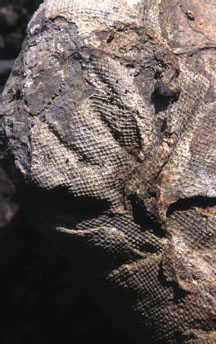
Close-up view of the fabric imprint on a solid piece of cement. David R. Gray photograph.
More than a hundred years of industrial activity has had a powerful impact on the wildlife, vegetation and ecological processes of Tod Inlet.
From the present point of view, the remnants of the two cement company wharfs at Tod Inlet provide an interesting contrast. The largest wharf, with its skeleton of vertical concrete pilings, has been there since about 1907, though it was not the first wharf at Tod Inlet. It replaced the original wooden wharf built by John Greig or Joseph Wriglesworth for the Saanich Lime Company around the turn of the century. It is now the location of a colony of purple martins, nesting in a series of nesting boxes attached to the cement pilings.
The second cement company wharf, built by infilling with various materials sometime before 1916, is now eroding around the edges. Debris from the original factory buildings, discarded firebricks from the kilns, fragments of bags of cement, and clinker from the cement-making process are now eroding out onto the shore, revealing odd pieces of history. The former wharf now supports a picnic area, and two large cement-and-metal bollards once used for tying up ships accompany the picnic tables as a playground for children.
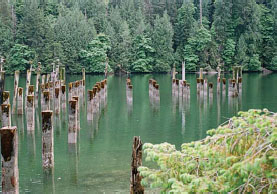
The cement piles of the first wharf, 2012. David R. Gray photograph.

The bollard for tying up ships at the second wharf, 2019. David R. Gray photograph.
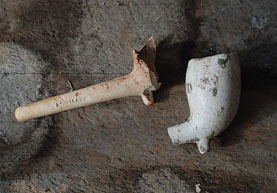
Clay pipes found on the shoreline near the plant. David R. Gray photograph.
A wide range of natural habitats at Tod Inlet support a diversity of wildlife species. Unfortunately, the only major biological studies that have been carried out in the area to date are those on plant communities.120 The major plant habitats are those associated with the Douglas fir, western red cedar and arbutus.
There have been few specific surveys or studies of other forms of life. The waters, the shorelines and the uplands of Tod Inlet are known to support many mammals, including cougars, black bears, black-tailed deer, raccoon, red squirrel, river otter, mink and harbour seal. Among the more common species of forest birds recorded are bald eagle, raven, turkey vulture, pileated woodpecker, hairy woodpecker, winter wren, towhee, robin and flicker. Along the shores of Tod Inlet many water birds are seen, including great blue heron, belted kingfisher, Canada goose, American merganser, bufflehead, goldeneye, American widgeon and glaucous-winged gull.
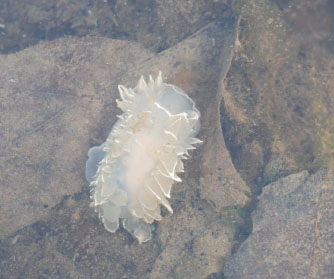
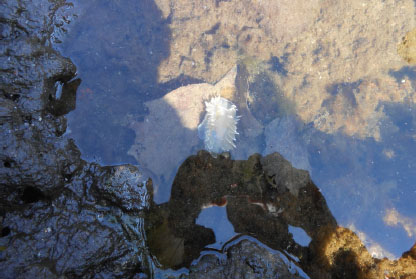
A white-line dirona (a nudibranch) at Tod Inlet. David R. Gray photographs.
In the marine waters of Tod Inlet, coho and chinook salmon, Pacific herring, lingcod and rock cod, striped sea perch, three-spine stickleback and tidepool sculpins all abounded into the 1960s. Current numbers and distribution of these fish species are unknown. Up until the 1950s, basking sharks and orcas also occasionally appeared in the inlet. Today the fish species confirmed to exist in the waters of Tod Inlet are limited: three-spine stickleback, coho salmon, cutthroat trout and Pacific herring for sure, and probably lingcod, rock cod, minnows, dusky sea perch, yellow shiner and bullhead sculpin.
Many marine invertebrates are still found in the inlet, among them moon jellyfish, octopus, clams, oysters, mussels, crabs, acorn barnacles and nudibranchs, but there have been few surveys to show their diversity or their current numbers. No intensive studies have investigated the long-term impact of industrial activities and settlement on these organisms.
Making cement pontoons at the wharf about 1913. The caption reads, “Raising cement pontoon with blocks to insert skids for launching.” Courtesy of the Butchart Gardens.
When I interviewed Jim Gilbert in the spring of 2000 about his recent observations in Tod Inlet, his comments were encouraging. There were live Pacific oysters and other shellfish in the area, though the Department of the Environment has continued to flag the inlet as having high levels of coliform bacteria, so no shellfish harvesting is permitted. In 1999–2000 the return of herring to Saanich Inlet showed hope for the possibility of recovery. When Jim was a kid, Elders from the Tsartlip band told him that what he saw in the 1940s and 1950s would one day fade away and again return, on a 50- or 60-year cycle.
The old cement pontoon, made at the company wharf in about 1913 and now resting in the mud below the old village, shows one small aspect of the recovery of life in the inlet. Photographs taken in 2011 and 2013 show more-or-less bare cement on the pontoon’s surface. Six years later the pontoon was covered in oysters and barnacles.
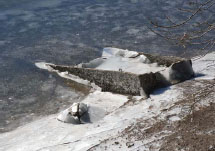
The old cement pontoon on the shore in winter 2011. David R. Gray photograph.
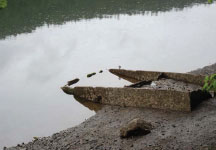
The same cement pontoon in 2013 with no oysters. David R. Gray photograph.
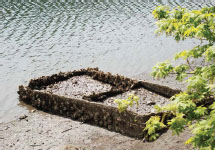
The same cement pontoon on the shore in 2019, encrusted with oysters and barnacles. David R. Gray photograph.
In April 2000 a group of students from Camosun College surveyed Tod Inlet from a 23-foot survey vessel, the Aluminator, utilizing a towfish with a video camera and an altimeter. The survey used the Seabed Imaging and Mapping System (SIMS), which provides images of the sea floor and records the depth at which fish and other species are detected. The students developed a classification system to identify and quantify both biological and geological objects on the bottom of the inlet.
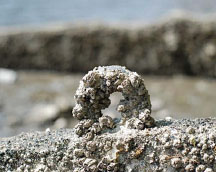
The encrusted ring for lifting the cement pontoon, 2019. David R. Gray photograph.
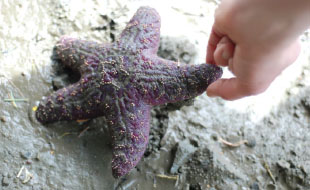
Purple sea star at Tod Inlet. David R. Gray photograph.
The 2001 report on the Camosun College study found that the distribution of plants and animals is directly related to the type of material on the sea floor (the “substrate”) of Tod Inlet. There was a higher percentage of gravel near the shoreline and more mud and sand sediment in the deep central part of the inlet. Over half of the sediment in Tod Inlet is composed of mud, sand and slightly gravelly mud and sand. The shoreline areas with more gravel showed more biological diversity. The substrate suitable for the important marine plant eelgrass (Zostera marina) is abundant in the inlet, but only a few eelgrass “meadows” were present. Other important plant groups identified were brown algae, kelp, green algae, red algae and coralline red algae. None of these groups had a wide distribution, and were most dense along the west shoreline and southernmost tip of the inlet. The most widely distributed bottom-dwelling animals were sea stars, especially the ochre and spiny pink sea stars. Sea stars were most abundant in the northern half of the inlet and least abundant in the area near the former cement plant. Piddock and horse clams were present, but not abundant, in the mud/sand areas along the east and west shorelines. Other animals noted were tubeworms and sea anemones, and in relatively sparse numbers, crabs, sea cucumbers, moon snails and nudibranchs.
Small fish species were recorded in limited numbers at the mouth of Tod Inlet, along the west side of the narrows and west of the village area, but they were not identified.
Man-made objects noted were mostly bottles and miscellaneous metal objects, as well as pipes, garbage and sunken logs.121
The Friends of Tod Creek Watershed, established in 2001, took on some of the objectives of the former Tod Creek Water Enhancement Society. The Friends’ stated mission is to protect and enhance the integrity and biodiversity of the Tod Creek watershed.
The SeaChange Marine Conservation Society, with a 100-year vision and a largely volunteer crew, has raised money and worked successfully to begin restoring the original marine habitat of Tod Inlet. They identified Tod Inlet as a promising locale in which to restore the natural aquatic environment because it is now a provincial park and because the cement industry and other sources of pollutants have moved out or been controlled.
To aid the recovery of habitat for marine life, SeaChange began transplanting shoots of eelgrass in 2000. That first year, volunteers planted almost 2,000 shoots. Eelgrass, a flowering intertidal marine plant, is a vital species that had disappeared from Tod Inlet. Its thick root mats had been badly disrupted by activities including log booming, the dragging of anchors, and pollutants. Eelgrass is vital to a rich marine environment because of the habitat it creates for marine life. It is also a direct source of food for the Tsartlip people.
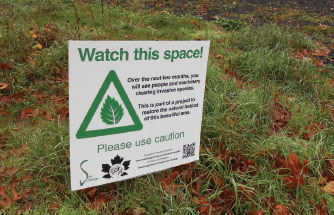
SeaChange sign at the land restoration site near the wharf. David R. Gray photograph.
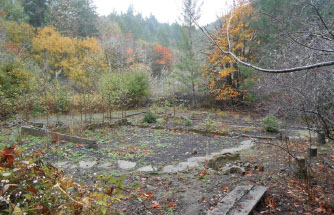
Clearing of invasive plant species in the white village site. David R. Gray photograph.
Another part of SeaChange’s 100-year vision includes the planting of native plant species, especially traditional W̱SÁNEĆ (Saanich) food and medicinal plants. Up beyond the shoreline, in areas where native vegetation has been replaced over the years by introduced and invasive species, volunteers, including schoolchildren, are removing invasive plant species like Himalayan blackberries and instead planting native cottonwoods, rose plants and redcurrant bushes.
The Friends of Tod Creek Watershed recently achieved a goal that was first suggested back in 1905: a fishway to help coho salmon and cutthroat trout make their way up Tod Creek and over the dam near Wallace Drive. Starting with planning visits and monitoring of water flow in 2002, they worked for 13 years to achieve the goal. In 2015 the Peninsula Streams Society worked with BC Parks, the Department of Fisheries and Oceans, local First Nations and the Butchart Gardens (owner of the dam) to complete a 30-metre fishway to help the fish get past the dam to spawn upstream. Fittingly, the fishway was financed by the Butchart Gardens and thus named Butchart’s Fishway—110 years later! Today, the fish passing through are monitored by camera. They include both resident and sea-run cutthroat trout, three-spine stickleback and coho salmon. Some fish have been tagged, but so far, as of 2020, no tagged salmon have returned as adults.
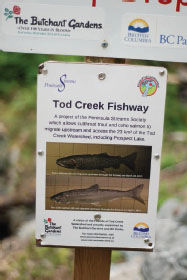
The sign at the new fishway on Tod Creek, showing the two fish species that are using the fishway, 2019. David R. Gray photograph.
The Butchart Gardens also purchased a pump-out boat in 2015 to collect sewage from boats in Brentwood Bay and Tod Inlet to decrease the amount of sewage dumped into the sea.
SeaChange began another recovery project in 2017: the location and removal of underwater debris on the inlet bed to reduce contaminants and allow space for the natural habitat to recover. Society volunteers removed bags of old concrete, boats, tires, metal pieces, bottles and tins from the seabed and took them away for safe disposal.
In the same year, with the assistance of BC Parks, SeaChange led the creation of a new beach near the old wharf. This involved clearing the cement footings and backfill—including industrial waste from the cement factory, polluted topsoil, and metal debris from the tile plant—of the old man-made shoreline from about 1904, and replacing it with gravel and sand.
The newly restored beach is a perfect place for recreation and teaching. Earl Claxton Jr., an Elder of the Tsawout First Nation, teaches traditional knowledge here with storytelling, salmon bakes and the use of native plants. On my recent visit to Tod Inlet in 2019, I had the pleasure of meeting Earl on the beach at the tail end of a program he was giving to students from the University of Victoria.
In 2004, the hundredth anniversary of its humble beginning, the Butchart Gardens were designated a National Historic Site of Canada. In announcing the designation in 2004, the Historic Sites and Monuments Board of Canada stated the reasons for the designation of the gardens: “It represents the remarkable combination of three aspects of Canadian gardening history. First, the gardens represent the traits of an early 20th-century estate garden through its different types of gardens such as the Japanese Garden, the Rose Garden, the Italian Garden, the Star Pond and Jennie Butchart’s Private Garden. Second, the gardens evoke the early twentieth century beautification movement as expressed through the Sunken Garden. And third, the gardens rely upon the Victorian bedding out system to achieve their outstanding floral displays. These three aspects of the Butchart Gardens have been conveyed through the successive visions of Butchart family members.”122
The National Historic Site nomination had nothing to do with the cement industry, the immigrant community, preserving a piece of the traditional Tsartlip land or the ecological recovery of the inlet—just the gardens.

The totem pole at the Butchart Gardens, carved by Charles Elliott in 2004. David R. Gray photograph.

Detail of the totem pole showing the blue grouse, carved by Charles Elliott. David R. Gray photograph.
As part of the garden’s centennial celebrations, Tsartlip master carver Charles Elliott was commissioned to carve a classic Coast Salish totem pole. The pole features Raven, Beaver and Grouse, Otter with pups and a clam, and at the base, Frog—beings of great importance to the Tsartlip people and of great significance to the ecology of Tod Inlet. The pole was dedicated on September 9, 2004.
An article by “Ivanhoe,” in the Winnipeg Tribune of September 14, 1922, entitled “The Sunken Garden or Beauty and the Beast,” contrasts the remnants of the cement factory to the increasingly popular Sunken Garden: “In the foreground … stand the tall cement chimneys and the ungraceful bulk of a cement factory. You wonder why Mr. Butchart located beauty so near this beast until you are told that without the beast there would have been no beauty. The sunken garden with its multifarious charms is really a child of the ugly cement plant…. And out of that happy thought of reparation has come the far-famed garden of today.”
One of the wonderful characteristics of the Tod Inlet story are the number of such unexpected developments—the occurrences no one could reasonably have predicted. Perhaps the most significant of them is the story of Jennie Butchart’s garden. As her husband immersed himself in producing cement, Jennie was busy encouraging gardens and beautiful flowers. Early on her house garden attracted visitors, and when her garden grew to include the spent quarry, her visitors started coming by boatloads and busloads. In the end, Jennie’s gardens brought far more acclaim and fame to the family than did Robert’s cement plant.
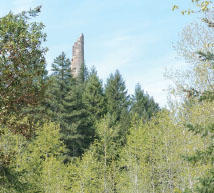
The last chimney as it begins to crumble in 2019. David R. Gray photograph.
The garden was to grow to become a huge tourist attraction that benefited the whole province. Who could have imagined in 1910 that the cement plant would one day be overshadowed by the flower garden? Today, the Butchart Gardens is still a family business and is open every day of the year. A booming tourist destination, it attracts a million visitors a year from around the world. On the other hand, the cement plant has been reduced to the remnants of two wharfs, a last crumbling chimney, and a few stacks of cement wharf pilings made more than a hundred years ago and never used.
There is another Beauty and the Beast story at Tod Inlet, on a much smaller scale. The rare, threatened and beautiful phantom orchid, known from only a few sites in BC, grows at Tod Inlet in an area that was once one of the most disturbed patches of ground in a vast industrial landscape. And why is this beauty now here? Phantom orchids prefer limestone soils, and there is plenty of exposed limestone left over at Tod Inlet, from the days of the beast.
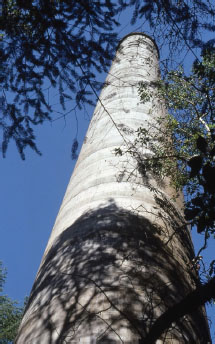
The last surviving cement plant chimney from its base, 1980s. David R. Gray photograph.
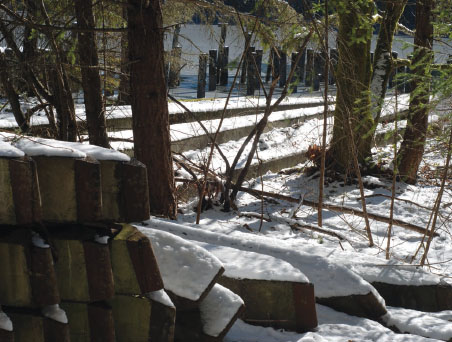
Piles of unused piles in the winter snow. David R. Gray photograph.

Phantom orchid, the limestone lover. David R. Gray photograph.
The cultivated gardens preserve two of the quarries where the Chinese labourers toiled by hand to remove limestone for the cement plant. The first quarry became the Ross Fountain; the second, the famous Sunken Garden. The third, Quarry Lake, is also owned by the gardens, and now serves as a water reservoir.
When Heritage BC called for nominations for places in British Columbia of heritage importance to the Chinese Canadian and South Asian Canadian communities under the BC Heritage Conservation Act, I submitted nominations of Tod Inlet as a place of historical significance to both. Along with several other nominations, the Tod Inlet nominations were accepted in 2016. Tod Inlet is now officially recognized as a Historic Place of Canada.
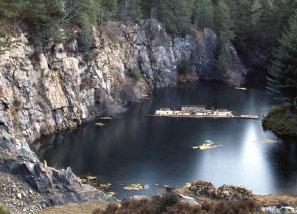
The first quarry today: the Ross Fountain in winter. David R. Gray photograph.
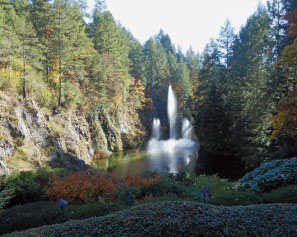
The Ross Fountain in the fall, 2019. David R. Gray photograph.
Tod Inlet is the place where an important part of BC’s unique industrial history began. Though the individual stories of the Chinese workers of Tod Inlet are largely lost to us now, we can assume that among the more than 200 men who laboured here, there were those who made contributions of great significance. Certainly their experience as a whole, of hard work for low pay far from the place of their birth, is a familiar theme in the BC story. The story of the Sikh contributions began with a relatively few men from Punjab providing labour for BC’s first major cement plant. Over time, it expands to involve people and communities across BC. When the Sikh labourers left Tod Inlet in about 1911, many of them travelled to Vancouver, Golden and Ocean Falls to work in the sawmills there. Their descendants became sawmill owners and operators, entrepreneurs and developers, company owners, politicians and businessmen. Their legacy, along with the long-standing legacy of the Tsartlip and other First Nations and the immigrant settlers, is an essential part of BC’s story.
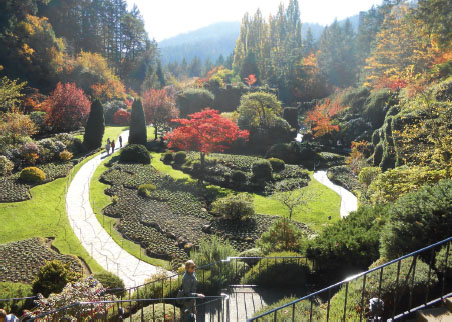
The second quarry became the Sunken Garden at the Butchart Gardens. David R. Gray photograph.